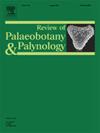Famennian phytoplankton from the Hongguleleng Formation of Western Junggar, NW China
IF 1.7
3区 地球科学
Q2 PALEONTOLOGY
引用次数: 0
Abstract
The Hongguleleng Formation is a stratigraphical unit in proximity to the Frasnian/Famennian and Devonian/Carboniferous boundaries within the Kazakhstan Palaeoplate. Nonetheless, the absence of conodont, ammonoid, and brachiopod assemblages in some significant stratigraphical horizons limits the precise subdivision of the formation. To address this issue, a new palynostratigraphical analysis was conducted at the Gennaren section, in order to provide additional data that would facilitate the delineation of biostratigraphical zones within the Hongguleleng Formation. In this study, a total of forty-one phytoplankton species belonging to 20 genera have been identified, including some in open nomenclature. The phytoplankton taxa can be separated into three assemblages. Of particular interest is the species Ammonidium levigatum, which exhibits potential as an index acritarch species for equivalents of the VCo miospore Zone in eastern Europe. The phytoplankton assemblage described here has its taxonomic composition closest to northeastern Europe (Poland) and belongs to the Laurussia Realm at a time of high cosmopolitanism. According to the percentage of marine and terrestrial palynomorphs observed in the Gennaren section, the sedimentary environment of the lower member of the Hongguleleng Formation is interpreted to have undergone a dynamic transformation, shifting initially from a coastal environment to a neritic one, subsequently shifting to a deep-water setting, and ultimately reverting back to a neritic environment.
准噶尔西部红古岭组法门期浮游植物
红古冷组是哈萨克斯坦古板块内靠近弗拉斯系/法门系和泥盆系/石炭系界线的地层单元。然而,在一些重要的地层中,牙形石、菊石和腕足类组合的缺失限制了对地层的精确细分。为了解决这一问题,我们在Gennaren剖面进行了新的孢粉地层分析,以提供更多的数据,以促进红古冷组生物地层带的划定。本研究共鉴定了浮游植物41种,隶属于20属,其中包括一些公开命名的浮游植物。浮游植物分类群可分为三个组合。特别令人感兴趣的是菊苣属(amidium levigatum),它显示出作为东欧VCo小孢子区当量的指数性主要物种的潜力。这里描述的浮游植物组合在分类组成上最接近欧洲东北部(波兰),属于高度世界主义时期的月湖王国。根据根纳伦剖面海相地貌和陆相地貌所占的比例,认为红古莱棱组下段沉积环境经历了一个动态的转变过程,从海岸环境到浅海环境,再到深水环境,最后又恢复到浅海环境。
本文章由计算机程序翻译,如有差异,请以英文原文为准。
求助全文
约1分钟内获得全文
求助全文
来源期刊
CiteScore
3.50
自引率
21.10%
发文量
149
审稿时长
6 months
期刊介绍:
The Review of Palaeobotany and Palynology is an international journal for articles in all fields of palaeobotany and palynology dealing with all groups, ranging from marine palynomorphs to higher land plants. Original contributions and comprehensive review papers should appeal to an international audience. Typical topics include but are not restricted to systematics, evolution, palaeobiology, palaeoecology, biostratigraphy, biochronology, palaeoclimatology, paleogeography, taphonomy, palaeoenvironmental reconstructions, vegetation history, and practical applications of palaeobotany and palynology, e.g. in coal and petroleum geology and archaeology. The journal especially encourages the publication of articles in which palaeobotany and palynology are applied for solving fundamental geological and biological problems as well as innovative and interdisciplinary approaches.

 求助内容:
求助内容: 应助结果提醒方式:
应助结果提醒方式:


